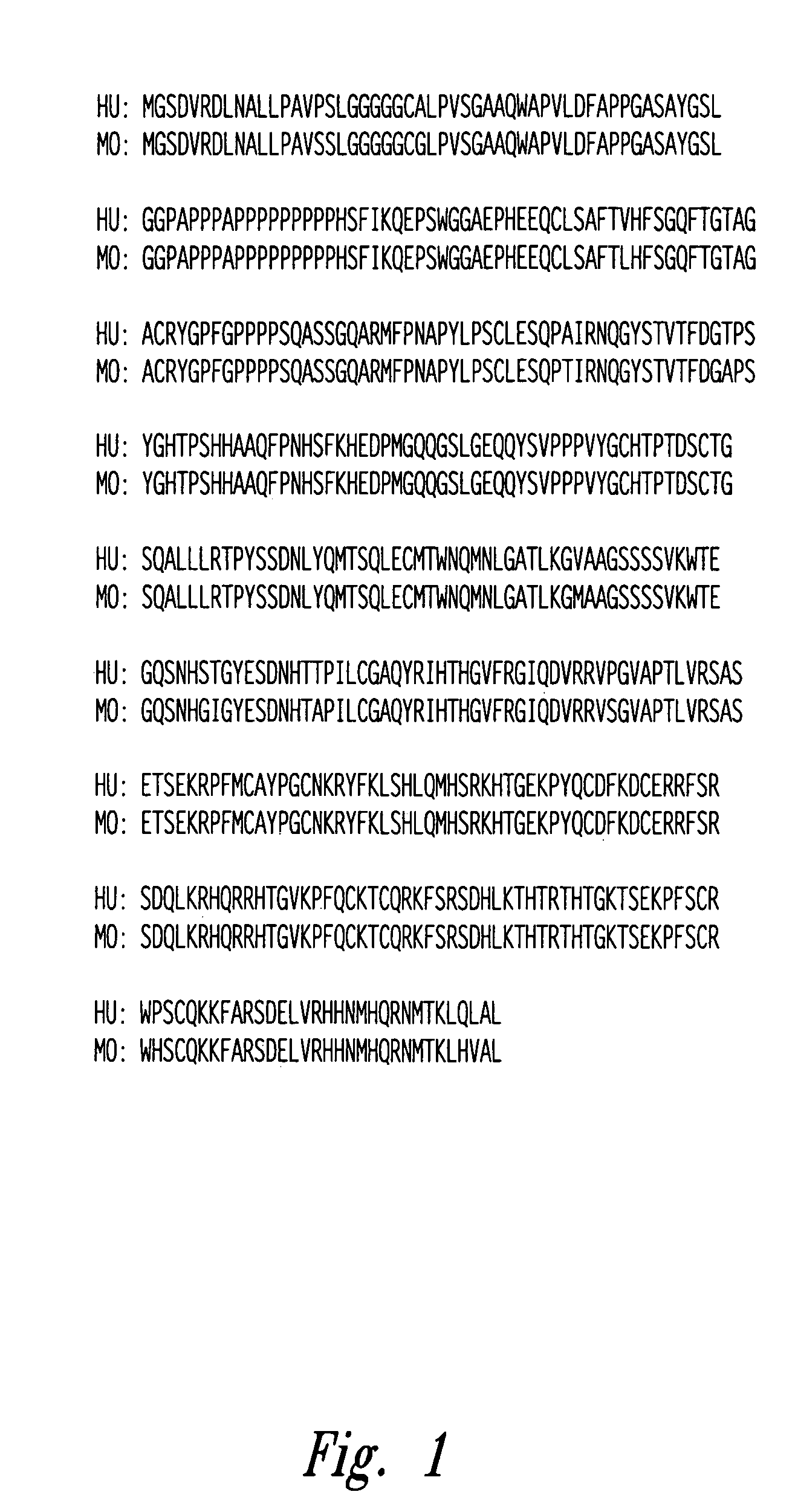Composition and methods for WTI specific immunotherapy
a technology of immunotherapy and specificity, applied in the field of immunotherapy of malignant diseases, can solve the problems of difficult interpretation, no vaccine or other universally successful method for cancer and leukemia prevention or treatment, and cancer and leukemia, and achieve the effects of inhibiting the onset, inhibiting the progression and/or metastasis of an existing disease, and inhibiting the development of a malignant diseas
- Summary
- Abstract
- Description
- Claims
- Application Information
AI Technical Summary
Benefits of technology
Problems solved by technology
Method used
Image
Examples
example 1
Identification of an Immune Response to WT1 in Patients with Hematological Malignancies
[0110]This Example illustrates the identification of an existent immune response in patients with a hematological malignancy.
[0111]To evaluate the presence of preexisting WT1 specific antibody responses in patients, sera of patients with AML, ALL, CML and severe aplastic anemia were analyzed using Western blot analysis. Sera were tested for the ability to immunoprecipitate WT1 from the human leukemic cell line K562 (American Type Culture Collection, Manassas, Va.). In each case, immunoprecipitates were separated by gel electrophoresis, transferred to membrane and probed with the anti WT-1 antibody WT180 (Santa Cruz Biotechnology, Inc., Santa Cruz, Calif.). This Western blot analysis identified potential WT1 specific antibodies in patients with hematological malignancy. A representative Western blot showing the results for a patient with AML is shown in FIG. 2. A 52 kD protein in the immunoprecipit...
example 2
Induction of Antibodies to WT1 in Mice Immunized with Cell Lines Expressing WT1
[0112]This Example illustrates the use of cells expressing WT1 to induce a WT1 specific antibody response in vivo.
[0113]Detection of existent antibodies to WT1 in patients with leukemia strongly implied that it is possible to immunize to WT1 protein to elicit immunity to WT1. To test whether immunity to WT1 can be generated by vaccination, mice were injected with TrampC, a WT1 positive tumor cell line of B6 origin. Briefly, male B6 mice were immunized with 5×106 TrampC cells subcutaneously and boosted twice with 5×106 cells at three week intervals. Following immunization to TrampC, a WT1 specific antibody response in the immunized animals was detectable. A representative Western blot is shown in FIG. 3. These results show that immunization to WT1 protein can elicit an immune response to WT1 protein.
example 3
Induction of Th and Antibody Responses in Mice Immunized with WT1 Peptides
[0114]This Example illustrates the ability of immunization with WT1 peptides to elicit an immune response specific for WT1.
[0115]Peptides suitable for eliciting Ab and proliferative T cell responses were identified according to the Tsites program (Rothbard and Taylor, EMBO J. 7:93–100, 1988; Deavin et al., Mol. Immunol. 33:145–155, 1996), which searches for peptide motifs that have the potential to elicit Th responses. Peptides shown in Table I were synthesized and sequenced.
[0116]
TABLE IWT1 PeptidesPeptideSequenceCommentsMouse: p6–22RDLNALLPAVSSLGGGG1 mismatch(SEQ ID NO:13)relative tohuman WT1sequenceHuman: p6–22RDLNALLPAVPSLGGGG(SEQ ID NO:1)Human / mouse:PSQASSGQARMFPNAPYLPSCLEp117–139(SEQ ID NOs:2 and 3)Mouse:GATLKGMAAGSSSSVKWTE1 mismatchp244–262(SEQ ID NO:14)relative tohuman WT1sequenceHuman:GATLKGVAAGSSSSVKWTEp244–262(SEQ ID NO:4)Human / mouse:RIHTHGVFRGIQDVRp287–301(SEQ ID NOs:15 and 16)Mouse:VRRVSGVAPTLVRS1...
PUM
| Property | Measurement | Unit |
|---|---|---|
| pH | aaaaa | aaaaa |
| binding constant | aaaaa | aaaaa |
| time | aaaaa | aaaaa |
Abstract
Description
Claims
Application Information
 Login to View More
Login to View More - R&D
- Intellectual Property
- Life Sciences
- Materials
- Tech Scout
- Unparalleled Data Quality
- Higher Quality Content
- 60% Fewer Hallucinations
Browse by: Latest US Patents, China's latest patents, Technical Efficacy Thesaurus, Application Domain, Technology Topic, Popular Technical Reports.
© 2025 PatSnap. All rights reserved.Legal|Privacy policy|Modern Slavery Act Transparency Statement|Sitemap|About US| Contact US: help@patsnap.com



